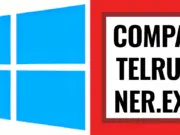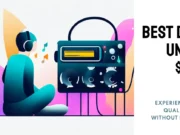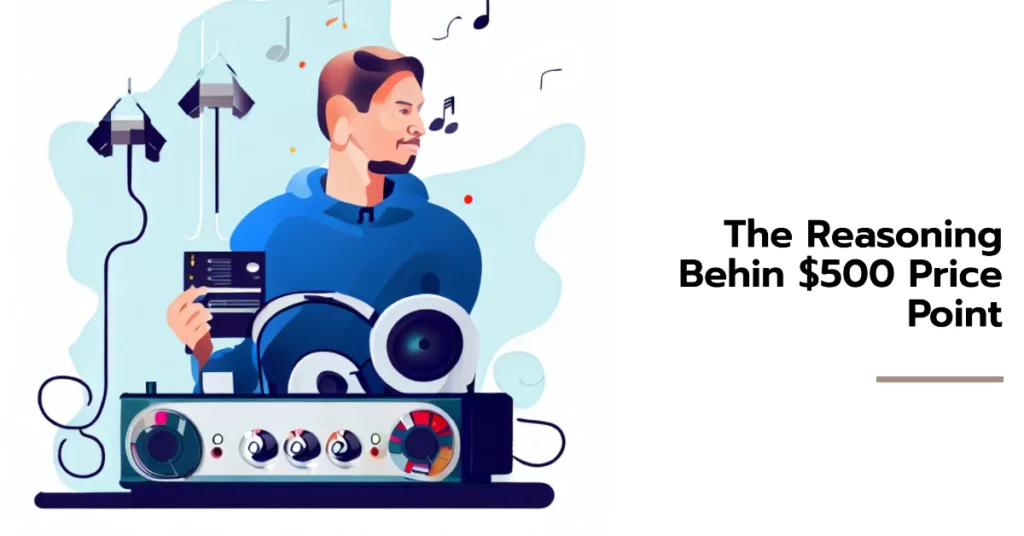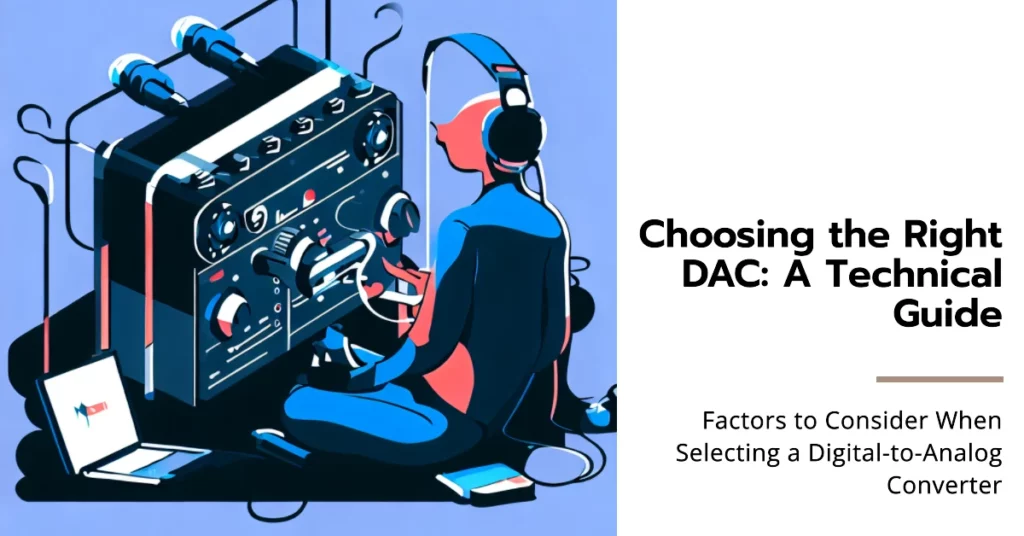We’ve all been there—spending money on high-quality headphones or speakers, eager to dive into our favorite tunes, only to discover the sound isn’t as crisp, detailed, or immersive as we’d hoped. The culprit? More often than not, it lacks a good digital-analog converter or DAC.
Imagine missing out on the subtle intricacies of a song, the gentle guitar strumming, or the clear distinction between instruments—all because your audio source isn’t translating digital signals effectively. Without the right DAC, it’s like looking at a masterpiece through a foggy window.
But fear not, audiophiles and music lovers alike. If you’re pursuing top-tier sound without breaking the bank, we’ve curated a list to guide you to the best DAC under 500 $. Dive in, and let’s reclaim the audio quality you truly deserve.
Why the $500 Price Point?
In the realm of high-fidelity audio, the question of why the $500 price point for DAC (Digital-to-Analog Converter) equipment continues to resonate among enthusiasts and audiophiles. To dissect this inquiry, one must delve into the intricate world of digital audio conversion and the demands of discerning listeners.
At this juncture, it’s pivotal to acknowledge that DACs are not created equal. A $500 DAC occupies a sweet spot, balancing performance and cost-effectiveness. These devices feature advanced circuitry, such as asynchronous USB interfaces, which ensures low jitter and optimal data transfer rates.
However, it’s crucial to fathom the cost structure underpinning DAC manufacturing. Precision components like ESS Sabre DAC chips and high-end capacitors contribute significantly to the price point. Additionally, meticulous engineering is essential to minimize distortion and maintain a high signal-to-noise ratio.
For audiophiles, the $500 threshold offers a tempting range of options. These DACs are often engineered to support various audio formats, including MQA, DSD, and FLAC, catering to a broad spectrum of preferences.
In conclusion, the $500 price point for DACs epitomizes a harmonious convergence of quality and affordability in the audiophile world. This level of investment opens doors to aural nirvana for enthusiasts seeking impeccable sound reproduction without venturing into the stratospheric price ranges of esoteric audio equipment.
Factors to Consider When Choosing a DAC
In the ever-evolving landscape of audio technology, selecting the right Digital-to-Analog Converter (DAC) demands careful consideration. This pivotal component can significantly influence your auditory experience.
Here, we delve into the crucial factors to consider when choosing a DAC.
1. DAC Chip Quality:- The DAC chip itself is at the heart of every DAC. Not all chips are created equal. High-end DACs boast Burr-Brown, ESS Sabre, or AKM DAC chips, renowned for their precision and clarity. Ensure your choice aligns with your sonic preferences.
2. Resolution and Sample Rate:- The bit depth and sample rate determine a DAC’s ability to reproduce audio accurately. A higher bit depth (e.g., 24-bit) and sample rate (e.g., 192kHz) allow for greater detail and fidelity, especially for high-resolution audio formats.
3. Connection Options:- Consider your source devices and connectivity needs. DACs offer various inputs, including USB, optical, coaxial, and Bluetooth. Choose one compatible with your equipment to avoid compatibility issues.
4. Analog Output Stage:- The analog output stage, including op-amps and output capacitors, influences the final sound quality. Premium DACs incorporate discrete components for a cleaner and more refined signal path.
5. Portability:- For those on the move, portable DACs are available. These compact devices offer enhanced sound quality for smartphones and laptops, making them ideal for audiophiles on the go.
6. Price Range:- DACs span a wide price spectrum. Consider your budget and balance it with your desired audio quality. While high-end DACs offer unmatched performance, budget-friendly options can still deliver impressive results.
7. Brand Reputation:- Reputable brands like Chord Electronics, Schiit Audio, and AudioQuest are known for their exceptional DAC offerings. research brand reputation and customer reviews to gauge reliability.
8. Additional Features:- Some DACs have built-in features like headphone amplifiers, volume control, or support for multiple audio formats (DSD, MQA, etc.). Evaluate these extras based on your specific needs.
In conclusion, selecting the right DAC demands meticulously evaluating these factors. Your choice should align with your audio preferences, equipment, and budget, enhancing your listening pleasure.
Review of The Best DAC Under 500 $
1. Cambridge Audio DacMagic 100
When elevating your audio experience without breaking the bank, the Cambridge Audio DacMagic 100 emerges as a stellar choice. This digital-to-analog converter (DAC) is a testament to the brand’s commitment to delivering exceptional audio quality.
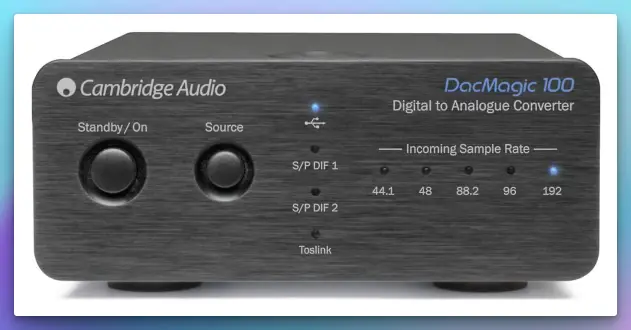
Let’s investigate why the Cambridge Audio DacMagic 100 is hailed as one of the best DACs under 500 $.
Impressive Wolfson DAC: At its core, the DacMagic 100 boasts a 24-bit Wolfson DAC – a key player in high-resolution audio. This formidable DAC chip ensures that your music is decoded with utmost precision, offering a depth and clarity that’s truly remarkable in this price range.
Versatile Connectivity: The DacMagic 100 offers a trifecta of connectivity options: Toslink, S/PDIF, and USB inputs. Whether you’re connecting it to your TV, CD player, or computer, this DAC has you covered. This versatility allows you to integrate it seamlessly into your existing audio setup.
Enhanced Soundstage: What sets the DacMagic 100 apart is its ability to widen the soundstage, immersing you in a sonic landscape that’s both rich and detailed. It transforms your music into an auditory journey, making it a valuable addition to audiophiles’ arsenal.
Build Quality: Crafted with precision and finesse, the DacMagic 100 exhibits an elegant yet robust build. Its sleek black finish adds a touch of sophistication to your audio setup and reflects the quality within.
Affordability: Perhaps the most compelling aspect of the DacMagic 100 is its affordability. Priced under $500, it strikes a harmonious balance between performance and cost, making it accessible to many enthusiasts.
In conclusion, the Cambridge Audio DacMagic 100 deserves its place among the best DAC under $500. Its Wolfson DAC, versatile connectivity, immersive soundstage, impeccable build, and affordability make it a compelling choice for those seeking to enhance their audio experience without breaking the bank.
Pros:-
High-Quality Wolfson DAC: Including a 24-bit Wolfson DAC chip ensures exceptional audio clarity and precision, providing a noticeable improvement in sound quality.
Versatile Connectivity: With multiple input options, including Toslink, S/PDIF, and USB, the DacMagic 100 can be easily integrated into various audio setups, accommodating different source devices.
Enhanced Soundstage: This DAC excels at widening the soundstage, creating a more immersive listening experience that reveals intricate details in your music.
Sturdy Build: The DacMagic 100 boasts a well-crafted and elegant design with a sleek black finish, making it a visually appealing addition to your audio setup.
Affordable: Positioned under $500, it provides excellent value for money, offering high-end DAC performance without the exorbitant price tag.
Cons:-
No Analog Inputs: The DacMagic 100 lacks analog inputs, so it won’t accommodate devices with only analog output. This limitation may require additional adapters or converters for certain setups.
Limited Features: While it excels at its primary function as a DAC, it lacks advanced features in more expensive models, such as built-in headphone amplifiers or support for even higher sample rates.
USB Power: When connected via USB, it draws power from the USB port. While convenient, it may not provide enough power for demanding headphones, necessitating a separate power source or a dedicated headphone amplifier.
In summary, the Cambridge Audio DacMagic 100 offers outstanding audio quality and versatility at an affordable price, making it an excellent choice for most audiophiles. However, its lack of analog inputs and some advanced features might be limiting for those with specific audio requirements.
2. Cambridge Audio DacMagic 200M
When it comes to the realm of high-fidelity audio, the Cambridge Audio DacMagic 200M stands as a shining example of excellence in the sub-$500 DAC category. This remarkable device is not merely a digital-to-analog converter (DAC); it’s a gateway to sonic nirvana.
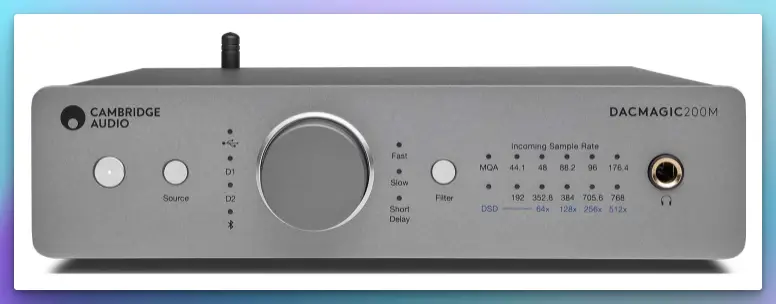
Let’s explore why the Cambridge Audio DacMagic 200M earns its reputation as one of the best DAC under 500 $.
MQA HiFi Mastery: At the heart of the DacMagic 200M lies its MQA (Master Quality Authenticated) capabilities, elevating your listening experience to unprecedented heights. It unfolds music like intricate origami, preserving every nuance and subtlety of your favorite tracks, making it a must-have for audiophiles seeking uncompromised audio fidelity.
Exceptional Headphone Amplification: This DAC is not just about decoding; it’s also an exceptional headphone amplifier. It breathes life into your headphones, driving them with authority and finesse. Whether using open-back reference headphones or high-impedance audiophile cans, the DacMagic 200M can effortlessly power them, ensuring an immersive listening experience.
Wireless Convenience: Embracing modernity, the DacMagic 200M offers Bluetooth connectivity, allowing you to stream music wirelessly from your devices. This flexibility ensures you’re not tethered to a single source, making your listening setup convenient.
High-Resolution Audio Support: With the ability to handle digital files up to an astonishing 24/768 or DSD512, the DacMagic 200M is a juggernaut in high-resolution audio. It caters to audiophiles with a penchant for studio-grade music formats.
Exquisite Lunar Grey Finish: Beyond its exceptional performance, the DacMagic 200M boasts an alluring Lunar Grey finish that complements any audio setup, adding an element of sophistication to your listening environment.
In conclusion, the Cambridge Audio DacMagic 200M is more than just a DAC; it’s an audiophile’s dream. With MQA HiFi capabilities, powerful headphone amplification, wireless convenience, support for high-resolution audio, and an elegant design, it firmly secures its place as one of the best DAC under 500 $, offering an unparalleled listening experience that transcends its price point.
Pros:-
MQA HiFi Excellence: The DacMagic 200M’s MQA support ensures studio-quality audio reproduction, preserving every detail and nuance of your music for an audiophile-grade experience.
Powerful Headphone Amplification: It doubles as a high-performance headphone amplifier, capable of driving a wide range of headphones with finesse, from demanding audiophile models to studio monitors.
Bluetooth Connectivity: Including Bluetooth allows wireless streaming convenience, enabling you to connect and play music from your devices without cables.
Support for High-Resolution Audio: Handling digital files up to an impressive 24/768 or DSD512, this DAC caters to those who prefer the highest quality audio formats.
Elegant Lunar Grey Finish: The DacMagic 200M excels in performance and aesthetics, featuring a sleek Lunar Grey finish that adds a touch of sophistication to your audio setup.
Versatile Connectivity: It offers various connection options, including USB, Toslink, and Coaxial, ensuring compatibility with various audio sources.
Cons:-
Price Point: While considered affordable for its feature set, it may still be on the higher budget for some consumers seeking a DAC under $500.
No Analog Inputs: The DacMagic 200M lacks analog inputs, limiting its compatibility with analog-only audio sources. Users with such sources may require additional converters.
Bluetooth Range: The Bluetooth connection’s effective range may be limited depending on your environment, potentially causing occasional connectivity issues at greater distances.
Complex Features: The abundance of features, such as MQA support and high-resolution audio capabilities, may be overwhelming for newcomers to high-fidelity audio, requiring a learning curve.
The Cambridge Audio DacMagic 200M is a standout DAC that excels in numerous aspects, including audio quality, headphone amplification, wireless convenience, and design aesthetics.
However, potential buyers should be aware of its price, potential limitations for analog sources, and the complexity of its feature set, which may not suit all users’ needs and preferences.
3. EverSolo DAC-Z6
The EverSolo DAC-Z6 emerges as an exemplar of auditory excellence, epitomizing the essence of premium audio at a modest budget. Priced sensibly under $500, it is the audiophile’s dream come true.

Crafted with the precision of a maestro, the EverSolo DAC-Z6 showcases the prowess of the ES9068 DAC, elevating your music to an ethereal realm. Its MQA decoding capability ensures that you experience music in its purest, most authentic form, unrivaled by many competitors in its price range.
What sets the EverSolo DAC-Z6 apart is the incorporation of Qualcomm’s QCC5125, a Bluetooth 5.0 chipset that establishes seamless connectivity, allowing you to delve into a wireless auditory journey without compromising sound quality.
The EverSolo DAC-Z6 accommodates DSD512 and PCM768kHz for the discerning listener, ensuring that every note and nuance is faithfully reproduced. Its technical prowess becomes evident in the minutiae of sound, where it excels in preserving the subtlest details.
In conclusion, the EverSolo DAC-Z6 stands tall as the best DAC under 500 $, offering audiophiles an opportunity to indulge in high-fidelity audio nirvana without breaking the bank. Its amalgamation of cutting-edge technology, exquisite craftsmanship, and affordability makes it a compelling choice for those seeking the best in audio reproduction.
Pros:-
Exceptional Sound Quality: The EverSolo DAC-Z6 boasts an ES9068 DAC and MQA decoding, ensuring audiophiles enjoy pristine, high-fidelity sound reproduction with rich details.
Wireless Convenience: Qualcomm’s QCC5125 Bluetooth 5.0 chipset offers seamless wireless connectivity for hassle-free music streaming.
High-Resolution Support: DSD512 and PCM768kHz compatibility guarantee that this DAC can handle the most demanding audio formats, preserving every nuance of your music.
Affordable Excellence: Priced under $500, it provides a remarkable value proposition for audiophiles seeking top-tier sound quality without a premium price tag.
Solid Build: Crafted with precision and durability in mind, the EverSolo DAC-Z6 exudes a premium feel with its construction.
Cons:-
Pricey for Beginners: While it’s affordable for audiophiles, it might be considered expensive for those new to high-end audio equipment.
Complex Setup: Achieving the best sound quality may require some technical know-how during setup, which could be challenging for beginners.
Size and Portability: It’s not the most compact DAC on the market, so it might not be the best choice for users who prioritize portability.
Limited Bluetooth Range: Bluetooth 5.0 is efficient but still has a limited range, so users who need a more extensive wireless range might need to look elsewhere.
In summary, the EverSolo DAC-Z6 offers exceptional sound quality and value for audiophiles under a $500 budget. Still, it may require technical expertise during setup and might not suit users looking for extreme portability or extended Bluetooth range.
4. Topping DX3 Pro+
The Topping DX3 Pro+ emerges as the vanguard of sonic refinement, unequivocally earning its status as the best DAC under 500 $. This audio virtuoso redefines the boundaries of affordability while delivering an auditory experience that transcends expectations.
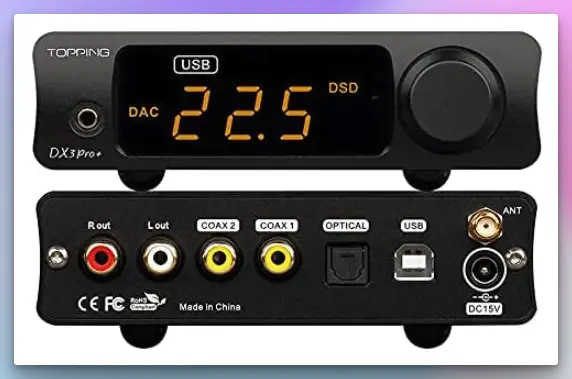
At the heart of this masterpiece lies the ES9038Q2M DAC, a paragon of digital-to-analog conversion prowess, ensuring audio purity that’s nothing short of sublime. DSD512 capability caters to the most discerning audiophiles, unraveling music’s intricate tapestry with finesse.
What sets the Topping DX3 Pro+ apart is its NFCA (Nested Feedback Composite Amplifier) technology, an audiophile’s dream come true. This proprietary innovation catapults headphone and pre-amplification performance to uncharted heights, rendering every note with unparalleled precision.
Including Bluetooth 5.0 with LDAC support further elevates its versatility, allowing for high-resolution wireless streaming without compromise. It’s a convergence of cutting-edge technology and audiophile-grade components, a testament to Topping’s commitment to sonic excellence.
The Topping DX3 Pro+ is an indomitable force in DACs under $500. Its amalgamation of ES9038Q2M DAC, NFCA amplification, LDAC Bluetooth, and impeccable craftsmanship makes it a symphony of value and performance, catering to those who demand nothing but the zenith of audio fidelity.
Pros:-
Exceptional Sound Quality: The Topping DX3 Pro+ features the ES9038Q2M DAC, ensuring pristine audio reproduction with incredible clarity and detail.
Versatile Connectivity: Bluetooth 5.0 and LDAC support offer high-resolution wireless streaming options for modern devices.
NFCA Amplification: The Nested Feedback Composite Amplifier technology delivers powerful, high-fidelity sound for headphones and pre-amplification.
DSD512 Support: Audiophiles can enjoy the highest quality audio with DSD512 capability, allowing for an authentic listening experience.
Affordable Excellence: Under $500, it provides exceptional value for its audiophile-grade features and performance.
Cons:-
Complex Setup: Achieving the best sound quality may require some technical expertise during setup, which could be challenging for beginners.
Limited Portability: The Topping DX3 Pro+ is not the most portable DAC due to its size and design, which might not suit users looking for on-the-go options.
No Built-in Battery: Unlike portable DACs, it relies on external power, limiting its use when power sources are scarce.
Price Point: While it’s affordable for audiophiles, it might still be considered expensive for those new to high-end audio equipment or on a tight budget.
The Topping DX3 Pro+ is an exceptional DAC under $500, offering top-tier sound quality, versatility, and value for audiophiles. However, it may require some technical expertise for setup and might not be the best choice for users seeking extreme portability or those with budget constraints.
5. AudioQuest – DragonFly Red USB DAC
The AudioQuest – DragonFly Red USB DAC emerges as an undisputed champion in budget audiophile gear, securing its rightful place as the best budget DAC. This diminutive powerhouse punches above its weight, delivering a sonic experience that belies its modest price tag.
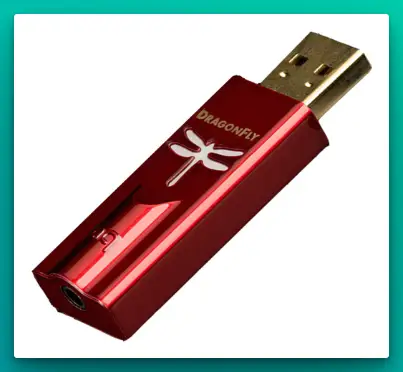
At the heart of the DragonFly Red is its USB DAC functionality, which transforms digital audio signals into aural masterpieces with remarkable precision. It’s a veritable sorcerer, conjuring up layers of sound that reveal nuances you might have never heard before.
The DragonFly Red’s compact form factor conceals an arsenal of high-end components. Its ESS Sabre 9016 DAC chip is renowned for extracting every drop of audio goodness from your digital music files, offering a level of fidelity usually reserved for more expensive equipment.
When it comes to power, the DragonFly Red doesn’t shy away. Its built-in headphone amplifier can easily drive even demanding headphones, ensuring that your music is delivered with the punch and clarity it deserves. This means that whether you’re on the go or at home, your listening experience is never compromised.
But its portability truly sets the DragonFly Red apart in the budget DAC arena. It’s small enough to fit in your pocket, making it the ideal companion for audiophiles on the move. Plug it into your laptop, smartphone, or tablet, and you’ll instantly upgrade your audio experience, no matter where you are.
In conclusion, the AudioQuest – DragonFly Red USB DAC is a remarkable testament to the notion that you don’t need to break the bank to savor high-quality audio.
Its prowess, courtesy of the ESS Sabre 9016 DAC chip, built-in amplifier, and portability, firmly establishes it as the best budget DAC for those who demand exceptional sound without a hefty price tag.
Pros:-
Exceptional Sound Quality: The DragonFly Red USB DAC, equipped with the ESS Sabre 9016 DAC chip, delivers high-fidelity audio with exceptional clarity and detail.
Affordable Audiophile Experience: It provides audiophile-grade sound quality at a budget-friendly price, making high-quality audio accessible to a wider audience.
Portable and Convenient: Its compact size allows for easy portability, making it a perfect choice for on-the-go music enthusiasts who want to enhance their listening experience with smartphones or laptops.
Versatile Compatibility: The DragonFly Red works seamlessly with various devices, including laptops, smartphones, and tablets, thanks to its USB connection.
Built-in Headphone Amplifier: The integrated amplifier can drive a wide range of headphones, ensuring your music sounds its best regardless of your headphone choice.
Cons:-
No Physical Volume Control: Some users may find the lack of a physical volume control knob or buttons on the device itself inconvenient, as they’ll need to adjust the volume through their connected device.
Battery Drain on Mobile Devices: When using it with mobile devices, the DragonFly Red may consume more battery power than the built-in audio output, although the difference is usually minimal.
Limited Connectivity: It primarily relies on USB connectivity, which may not be compatible with all devices, especially those lacking USB ports.
No Analog Outputs: While it excels as a USB DAC, it lacks analog outputs, limiting its use with non-digital audio systems.
In summary, the AudioQuest – DragonFly Red USB DAC offers remarkable sound quality and portability at an affordable price, making it an excellent choice for budget-conscious audiophiles. However, some users may miss physical volume controls, and its compatibility relies mainly on USB connectivity.
6. Audioengine D1 Premium
The Audioengine D1 Premium exemplifies auditory excellence, undoubtedly securing its place as the best DAC amp under $500. This unassuming audio gem transcends expectations, delivering an immersive auditory journey that leaves audiophiles in awe.
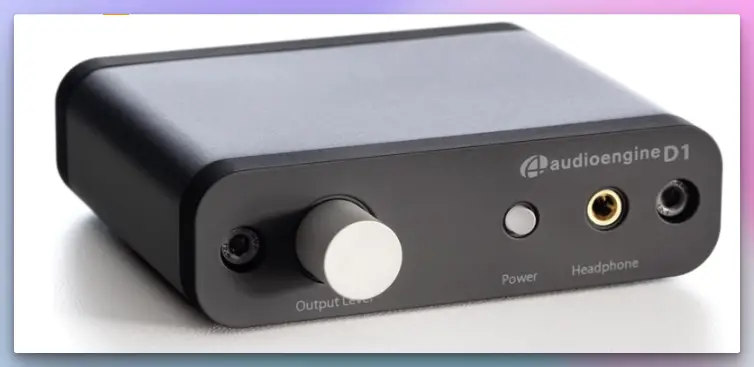
At the core of the Audioengine D1 Premium is its sophisticated 32-bit DAC, a testament to its commitment to unrivaled audio purity. This digital-to-analog converter is no mere mortal; it’s a sonic alchemist, transmuting digital signals into aural gold.
For the discerning audiophile, the D1 Premium offers versatility in spades. It functions as a DAC and headphone amplifier and as a preamp. This trifecta of capabilities ensures that your music, whether enjoyed through headphones or a full-fledged audio system, remains uncompromisingly exquisite.
Amping up its appeal to the gaming and music worlds, the Audioengine D1 Premium provides a sonic landscape where every note, every footstep, and every gunshot is reproduced with astonishing clarity. It’s the secret weapon for pro gamers and musicians seeking that competitive edge.
In the realm of connectivity, the D1 Premium leaves no stone unturned. It’s equally at ease with laptops and desktops, ensuring seamless integration into your digital life. The USB connection guarantees pristine audio delivery without a hint of distortion.
The Audioengine D1 Premium is the best DAC amp under $500. Its 32-bit DAC, preamp functionality, and impeccable craftsmanship are a testament to its unwavering commitment to audio excellence.
Whether you’re a discerning audiophile, a professional gamer, or a dedicated musician, the D1 Premium elevates your listening experience to extraordinary heights, all without breaking the bank.
Pros:-
Exceptional Sound Quality: The Audioengine D1 Premium features a 32-bit DAC, delivering audiophile-grade sound quality with remarkable clarity and precision.
Versatile Functionality: It serves as a DAC, headphone amplifier, and preamp, making it an all-in-one solution for various audio setups, from headphones to full audio systems.
Pro Gaming and Musician-Friendly: The D1 Premium is an excellent choice for professional gamers and musicians, providing a competitive edge with its immersive sound reproduction.
Easy Connectivity: It effortlessly connects to laptops and desktops via USB, ensuring a hassle-free and distortion-free audio experience.
Portable: Despite its versatility, it remains portable, making it suitable for home and on-the-go use.
Cons:-
Price Point: While it offers excellent value for its features, it may still be considered relatively expensive for those on a tight budget.
Limited Analog Outputs: It primarily relies on USB connectivity, which might not be compatible with older audio systems that lack USB inputs.
Lacks Wireless Connectivity: Some users may miss the convenience of wireless connectivity options, such as Bluetooth.
No Physical Volume Control: Adjusting the volume may require using your computer or device’s controls, which could be less convenient for some users.
In summary, the Audioengine D1 Premium is a versatile and high-quality DAC amp under $500, catering to audiophiles, gamers, and musicians alike. While it provides exceptional sound quality and functionality, its price point and limited analog outputs are potential downsides.
7. Qudelix-5K Bluetooth USB Dac Amp With Ldac
The Qudelix-5K Bluetooth USB DAC Amp with LDAC is a formidable contender in high-fidelity audio, unequivocally earning its position as the best DAC under 500 $. This unassuming audio marvel defies expectations, delivering an auditory experience that is nothing short of extraordinary.
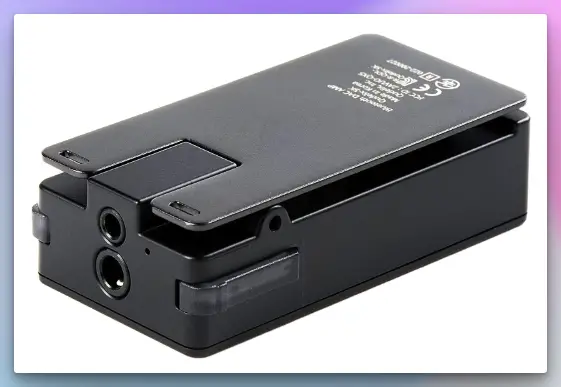
At its core, the Qudelix-5K boasts a dual ES9219 DAC configuration, a hallmark of precision and audio excellence. This duo of digital-to-analog converters operates in perfect harmony, ensuring that every sonic nuance is unveiled with remarkable clarity and detail.
One of the standout features of the Qudelix-5K is its support for LDAC, aptX Adaptive, aptX HD, and AAC codecs. This comprehensive codec compatibility ensures a wireless listening experience that is second to none, allowing you to savor your music in all its high-resolution glory.
Including 3.5mm unbalanced and 2.5mm balanced outputs caters to audiophiles with diverse headphone preferences. Whether using standard headphones or high-impedance, balanced models, the Qudelix-5K has you covered, delivering an uncompromising audio experience?
This DAC amp’s versatility extends beyond its wired capabilities. Its Bluetooth connectivity makes it a true wireless audio powerhouse, seamlessly pairing with your devices for a cable-free listening experience. Whether at home or on the go, the Qudelix-5K ensures your music is never tethered.
In conclusion, the Qudelix-5K Bluetooth USB DAC Amp with LDAC is indisputably the best DAC under 500 $. Its dual DAC configuration, comprehensive codec support, and versatile output options testify to its unwavering commitment to audio excellence. If you demand nothing but the pinnacle of sound quality and flexibility, the Qudelix-5K stands ready to elevate your audio journey to unparalleled heights.
Pros:-
Exceptional Sound Quality: The Qudelix-5K boasts dual ES9219 DACs, ensuring high-fidelity audio with exceptional clarity and detail.
Comprehensive Codec Support: With LDAC, aptX Adaptive, aptX HD, and AAC compatibility, it caters to audiophiles who demand high-resolution wireless audio.
Versatile Output Options: Including 3.5mm unbalanced and 2.5mm balanced outputs accommodates a wide range of headphone preferences and impedance levels.
Wireless Flexibility: Bluetooth connectivity makes it a versatile choice for home and on-the-go use, allowing cable-free listening.
Customizable Sound: The Qudelix app offers advanced EQ and sound customization options, allowing users to tailor the audio experience to their preferences.
Cons:-
Price: While offering excellent value for its features, it may be considered relatively expensive for budget-conscious consumers.
Complex for Beginners: The array of features and settings might be overwhelming for users new to high-end audio equipment or those seeking a simple plug-and-play solution.
Battery Life: Extensive use of high-quality codecs and wireless features can lead to faster battery depletion, so frequent charging may be required for extended listening sessions.
Size and Portability: It’s not as compact as other DAC/amps, which could affect its portability for some users.
In summary, the Qudelix-5K Bluetooth USB DAC Amp with LDAC offers exceptional sound quality and versatility but may be considered relatively expensive. Its advanced features and settings suit audiophiles and enthusiasts, but beginners may find it a bit complex. Additionally, its size may affect its portability for some users.
Conclusion
Navigating the world of audio equipment can be overwhelming, especially with the myriad of choices and technical jargon thrown around. Deciding on the best DAC can feel like a daunting task.
Without the right guidance, you could end up with a device that doesn’t deliver on its promise or, even worse, burns a hole in your wallet without any discernible upgrade in audio quality. It’s frustrating to realize you might not be extracting the best from your beloved music collection.
Thankfully, with our comprehensive guide focusing on the best DAC under 500 $, you’re now equipped with the knowledge to make an informed decision. Remember, quality sound is an investment in your audio experience. So, take that step, elevate your listening journey, and immerse yourself in the true essence of your favorite tunes.














